What is the food like in Peru? Everyone always wants to know what interesting things we have eaten on our journey, so I decided to share some of our entertaining eating experiences in Peru.
Anticuchos are very popular in Peru. This term can be used for any type of meat on a stick or a kebab. In almost every city we visited in Peru, we found Peruvian women on street corners with small grills selling them. The smells are intoxicating and it reminds you of summer. The kebabs on the street usually consist of chicken, pork, or hot dog and have a roasted potato on the tip of the skewer. Ají, a homemade Peruvian hot sauce from the area peppers, can be added upon request.
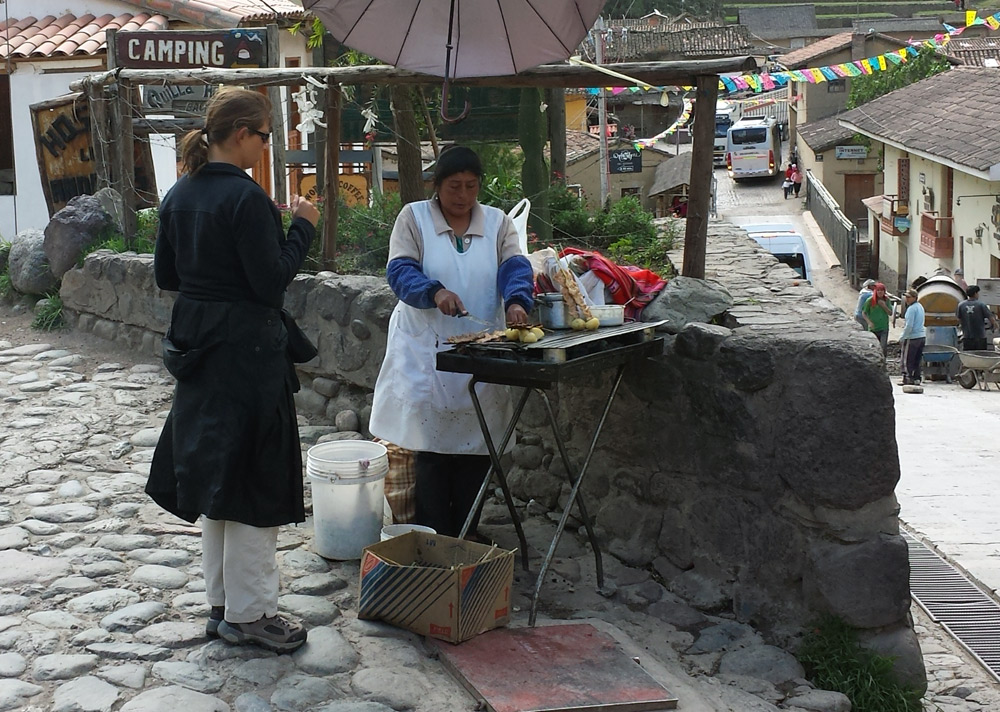
In Lima, we went in search of a place that specialized in anticuchos de corazón. These specific anticuchos are made of marinated beef hearts. The owner of Grimanesa Vargas Anticuchos once had a stand on the street, but it was so popular she was forced to get an establishment.
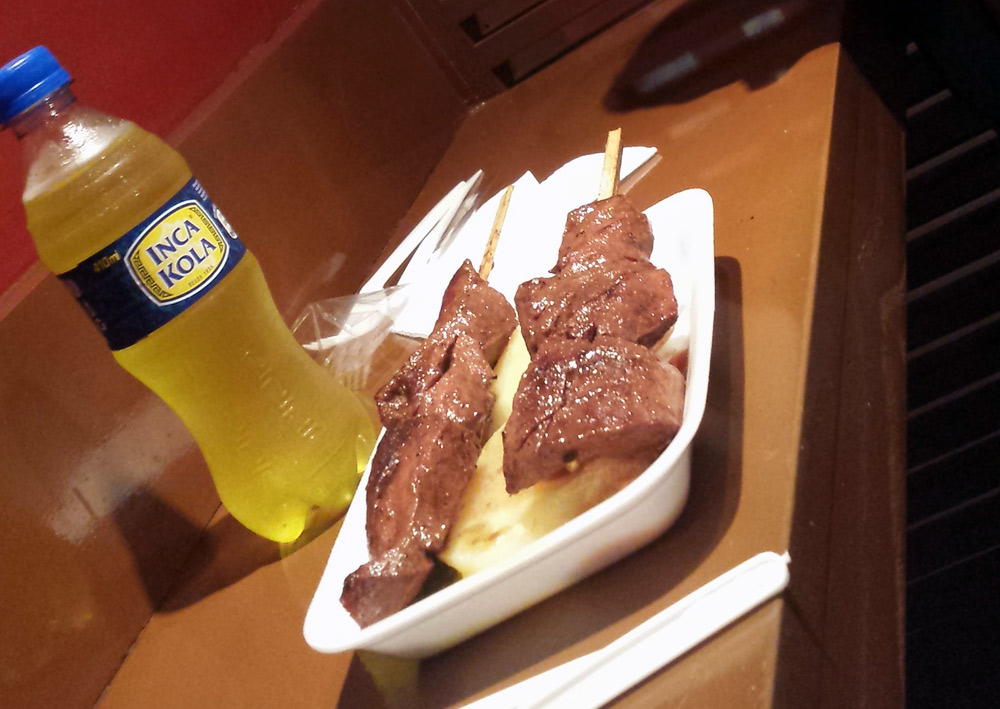
The meat itself was cooked to medium with a warm, pink center. The skewers glazed with garlic sauce taste like a good tender steak. Like most things in Peru, it comes with a potato and ají. We had the beef heart in two other restaurants, but you don’t always see them on the streets.
Many of the towns in the Cusco region are known for certain specialty food items. We stayed at a bed and breakfast called GringoWasi in the small town of Huarocondo. We woke up every morning to the sounds of cows, pigs and roosters. We found that eating and hiking were the main things for us to do in the area.
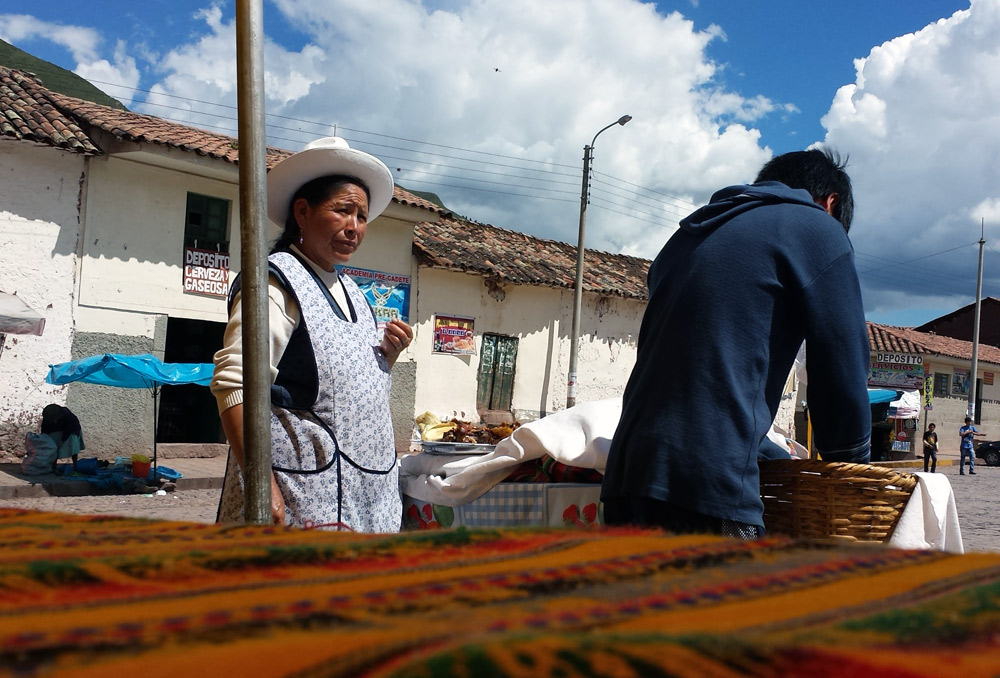
During the day, ladies would sell their lechon or pollo de gallina on the town square. Pollo de gallina is a roasted hen soup with vegetables. The soup wasn’t bad except it had some weird things added to it. It had potato and yuccu, which is a root vegetable known to the area. These are pretty traditional soup items here. However, there was some mystery veggie in that soup that we didn’t recognize. It looked similar to the potato, but the taste was really off and neither of us cared for it. We only cared to find out what it was, so we don’t order it again.
Huarocondo is known for lechon, a roasted suckling pig. They host an annual festival but it is available year round. There are several ladies stationed around the town square selling from big baskets of pork to people sitting at community tables. We shared a large portion of roasted pig and split a liter of beer for S/.20 (US$7). The lechon comes with tamales that have no meat. They are just salty masa with peanuts or sweet with a stick of cinnamon. You can have bread if you prefer if you want to make a sandwich. A side of cut up onions, spices and mint mixed with vinegar are on the table to top the pork.
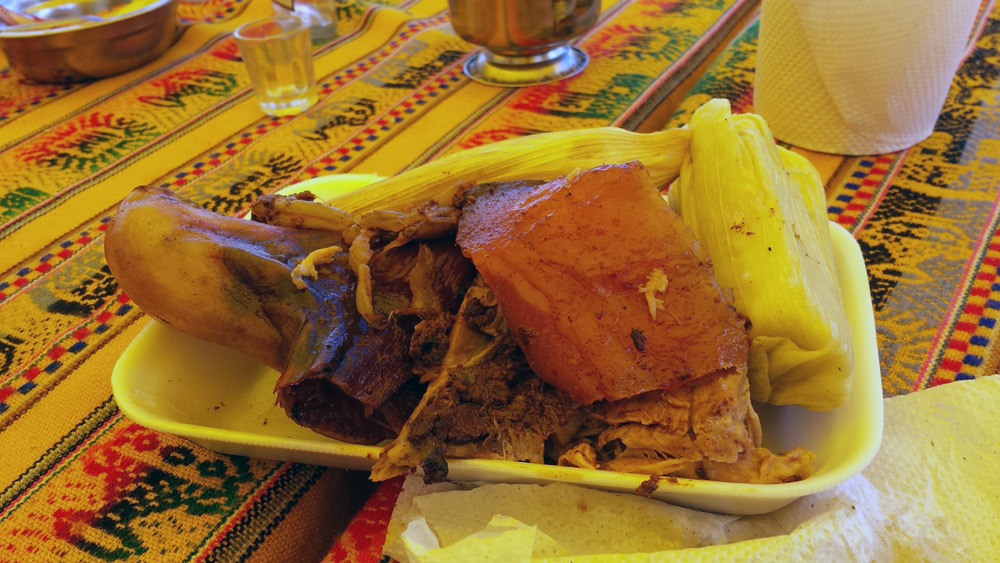
One lesson I learned was to be sure to eat the lechon before you hear your neighbor butchering the small pigs early in the morning. The squeals were a sound I don’t think I will ever forget. Mark was lucky enough to be in the shower.
The day we took our private tour of the Sacred Valley we stopped for lunch in Tipon which is known for Cuy or Guinea Pig. Guinea Pig is very popular with the Peruvians. Our guide and bed and breakfast owner, Lyle, took us to a Cuyeria that he stops at with any of his guests interested in trying it. I had said the night before that I didn’t know if I wanted to try it. He assured me that it was no big deal and it tasted like rabbit. That pretty much sealed the deal for me. I didn’t want to eat rabbit either. Mark was up for the challenge. I settled on chicken, and a bite of Mark’s just to say I had tried it. You can’t say you don’t like something if you don’t try it.
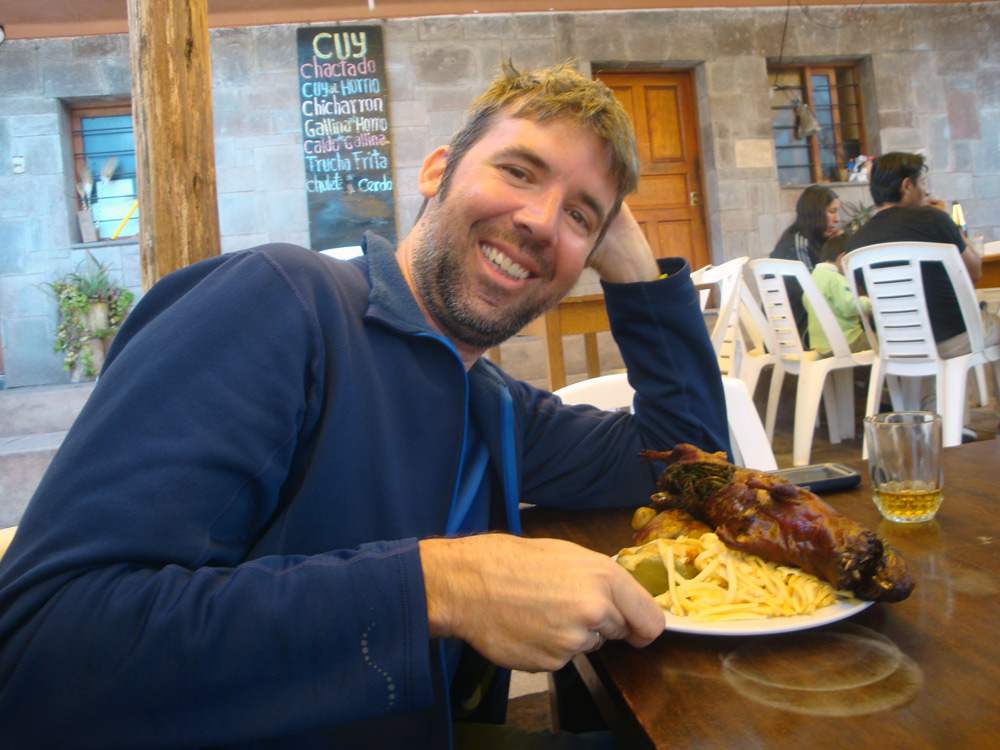
“It’s smiling at me” was the Christmas Story joke when the Cuy was placed on the table. The guinea pig was roasted whole. I could see the teeth. I looked at this rodent on Mark’s plate and thought, “I am so glad I got the chicken.”
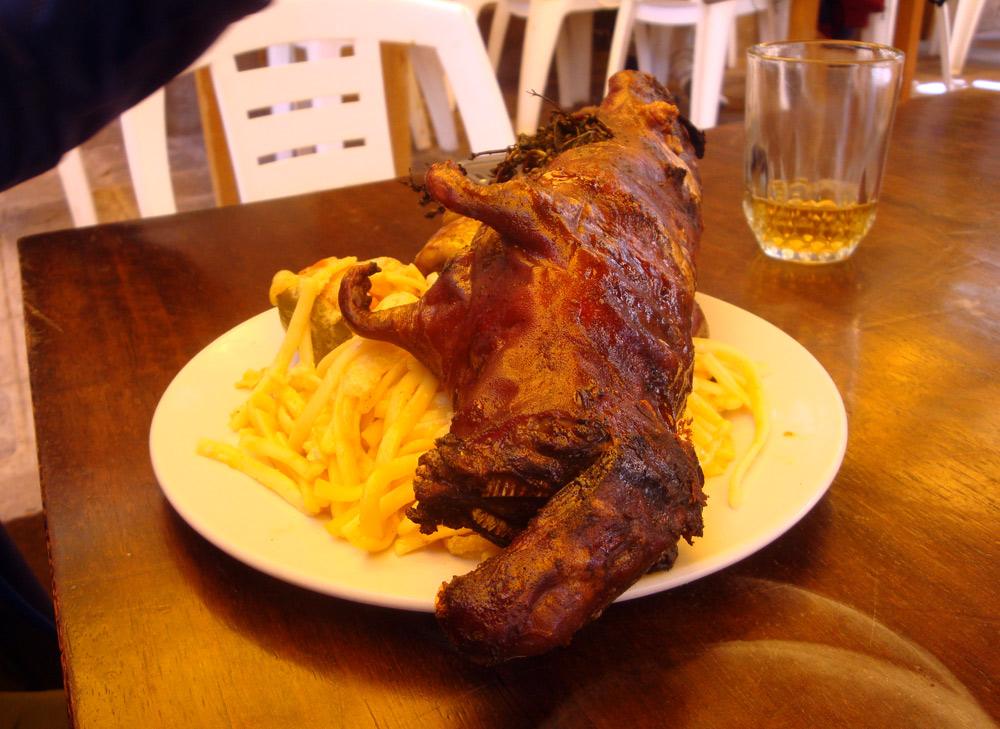
It was prepared with tons of herbs and baked in a brick oven. It cost around S/.33 (US$ 11) and came with roasted potatoes, spaghetti and stuffed peppers. The portions at most traditional places are really large. Lunch tends to be the main meal of the day for the locals.
The Guinea Pig wasn’t bad. It had a gamey taste to it. I don’t think I could handle a whole one. Mark seemed to enjoy it. There were a lot of little bones, so it is time consuming and difficult to eat. Every table in the place was filled with locals enjoying their Cuy lunch.
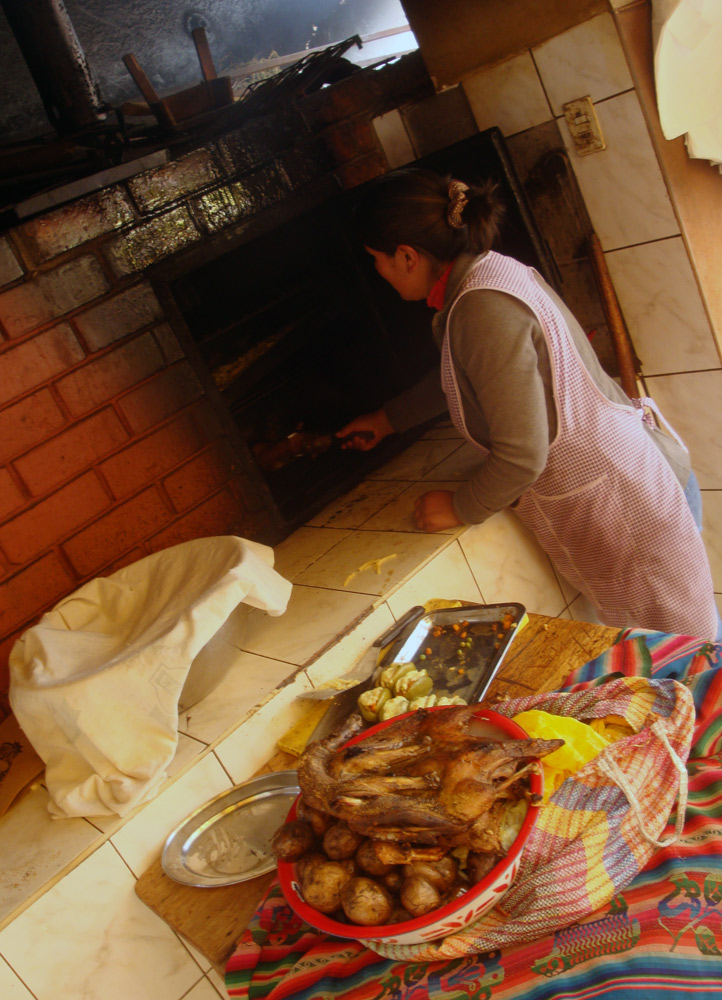
In Puno, we were able to have another special kebab treat. We went to El Tulipen where we both ordered the mixto kebabs. We had 3 skewers with Alpaca, Chicken and Beef. This was the first time we tried Alpaca. It is a very lean meat and seems similar to buffalo.
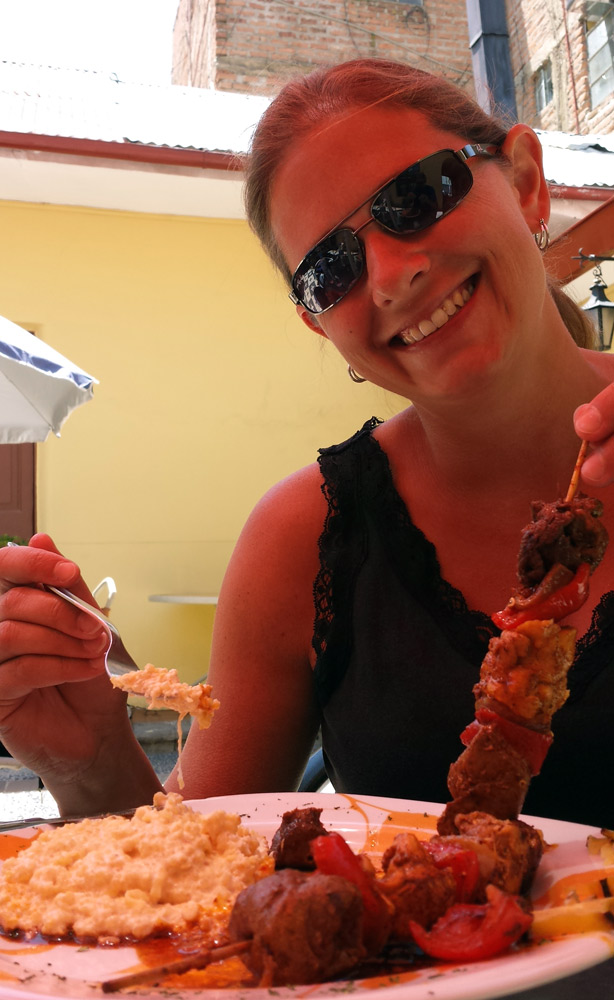
We had the opportunity to try it again in Arequipa. We had considered trying to cook it ourselves, but that didn’t work out. We had eaten cheap street food or at home a lot, so we decided to treat ourselves to a nice restaurant. In this area, they cook Alpaca in every way one would with pork or beef. After looking at several menus we opted for Zinagro which had plenty of Alpaca options.
I had Alpaca ribs with an herb butter sauce. It was like brown gravy with herbs and it was really delicious. The chops were a challenge to eat with a knife and fork. I just wanted to pick them up, but it was a classy place. They were a lot like pork country style ribs. They were cooked nice and tender, but didn’t really fall off the bone. It was more like eating a nicely done pork chop. Mark had Alpaca stroganoff with big button mushrooms and a creamy sauce.
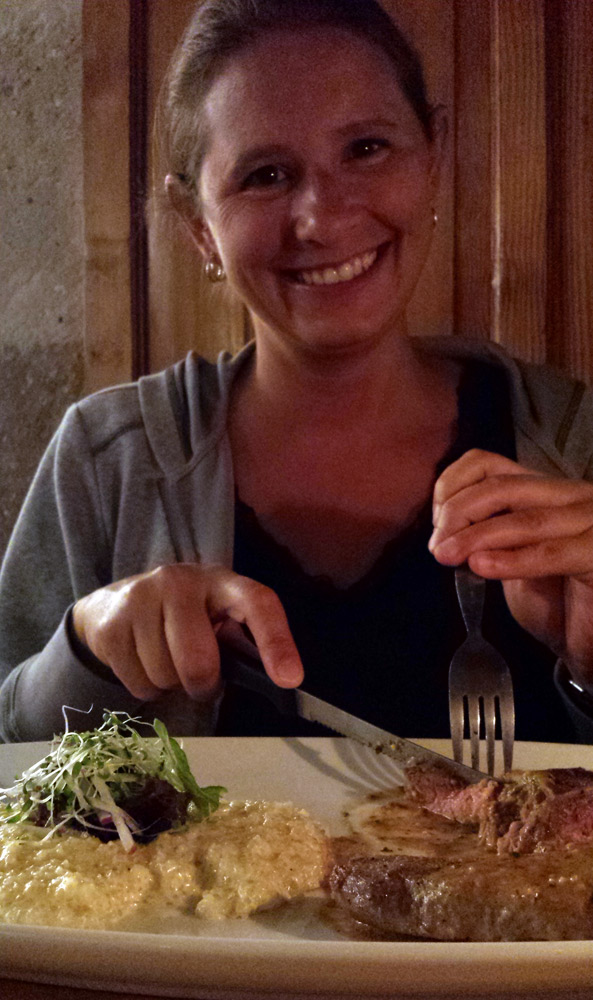
One of the things that made the dish that night was the quinoa. Yes, I am talking about one of the latest super grains in the United States. I was able to order quinoa risotto as a side dish to both the Alpaca dishes in Puno and Arequipa. Quinoa risotto has been one of my favorite dishes of the whole trip so far. It is little grains that have an al dente texture with a nice creamy cheese sauce. It reminds me a little of super creamy cheese grits. The grains are a little bigger, but it is buttery, creamy and delicious.
Apparently quinoa grows all over the inlands of Peru. It comes in a variety of colors. Peruvians use it to make a ton of things including beer. Unfortunately, a lot of locals can no longer afford it because worldwide demand has driven up the price. You still see it for sale in the local markets, but the price can be high. Locals and traditional restaurants tend to use it in soup. The soup is a combination of smaller amounts of quinoa with vegetables in some type of broth.
Fortunately, we have been lucky with most of our eating so far. Sure, we ate some kidneys in Cusco and maybe some random pork bits that we weren’t sure what they were from a stir-fry lady in Huarocondo. We have eaten salad and fruits when we shouldn’t. Americans who live in South America tell us most touristy places are fine for fruits and salads because they tend to wash stuff in filtered water. We are both sure our bodies have learned to fight off some new bacteria and that’s important since very few things are actually refrigerated.
We are finally getting better at navigating menus and we are branching out beyond chicken and rice. The only problem is the jargon changes for food in every place we go. In each new place we try to learn as many new food terms as we can, have faith that we know what we are doing, and hope we didn’t actually just order the intestines for our next meal.


So do they have loyalty cards there? Buy 4 guinea pigs and your 5th is free? Is Mark going to be shopping at Petco regularly when you return?
James recently posted…Las Vegas Blvd
He tried it once and he is good. I think if he is going to put that much effort into eating something it will be crab legs.
Julie recently posted…The ABC’s of Peruvian Food: Alpaca, Beef Hearts and Cuy
^ ^ ^ Free Bagel?
I laughed out loud at your line “I am so glad I got the chicken.” I kept thinking of my pet Guinea Pig “Truffles.” 🙁
Yep, I had a lot of gerbils and hamsters as pets. I just couldn’t do it. It was difficult for me to even try, but I felt like I had to do it. If I wasn’t in Peru, I would not have.
Julie recently posted…The ABC’s of Peruvian Food: Alpaca, Beef Hearts and Cuy
I can only imagine how much Mark was looking forward to posting that picture. Sex and freaky looking stuff sells!
James recently posted…Las Vegas Blvd
He was really excited about making it the cover photo.
Julie recently posted…The ABC’s of Peruvian Food: Alpaca, Beef Hearts and Cuy
I have loved reading about your travels. But this one takes the cake. I have always considered myself to be open minded about eating and trying new things. But there is no way in hell I would eat a guinea pig. Especially with how they prepared it. Seriously the whole thing just laying in your plate???? That’s horrible. I might have yried it in a stir fry or something hit dear Iod. That was a horrifying picture and I never had one as a pet. L.
I’ll be completely honest, I didn’t make it all the way through. Lyle recommended getting it fried instead of oven roasted, but oven roasted was the local specialty so I decided to go that route. One of the herbs they use when cooking it is really overpowering and I wasn’t a big fan of the herb. I had been sick for a couple days so I wasn’t 100% but felt I had to give it a shot. It being whole didn’t really bother me…I just thought of how Julie dismantles lobsters or crabs and went for it. I did just fine on the back half but as I got to the rib cage and the organs inside Lyle started talking about how much his Peruvian mother-in-law likes the brains in a very descriptive manner and I sort of hit a wall. I’d have it again, but it will be fried if I do.
Let’s be honest, put enough ranch dressing on it and Hoosier chicks would gobble it down in a heartbeat.
James recently posted…Las Vegas Blvd
I just found out that my classroom guinea pigs are a bit on the hefty side. They’re going on a diet high in fiber and aren’t making any plans to travel to Peru anytime soon.
what, no ‘rats on stick’??
It’s still early in the trip. 😀
well, I’m thinking here are some great new Sate Fair food choices here!
Also, I can just see you two coming back and running a food truck at Race events. You would be popular with the S. American drivers that’s for sure.
Hi Mark and Julie,
Just found your blog and must say I enjoyed reading it, and sorry about the brains comment Mark.
One note on the above, the chicken stew that you had was caldo de gallina and the mystery vegetable in the mix was a potato, I don’t remember the name but it is a potato that is dried and then later re-hydrated and used in a variety of soups. I am with you; I don’t care much for it either.
Sounds like you guys enjoyed your time as well as the remainder of your stay in Peru. We enjoyed having you two here with us and hope to maybe bump into you again in the future.
Ha! No worries, I don’t know if I would have made it through anyway. I should have taken your advice and gone with the fried.
Thanks for solving the vegetable mystery.
We had a great time and maybe our paths will cross again in the future.